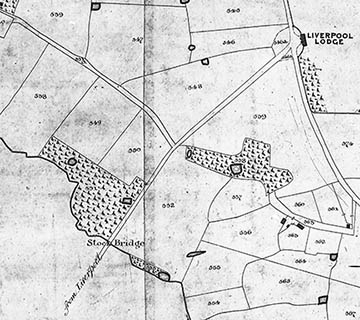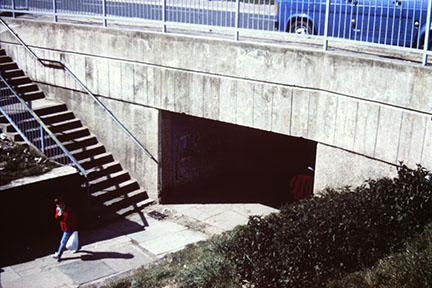- Home
- /
- Stockbridge Village
- /
- History – Stockbridge Village
Stockbridge Village may be a relatively new community (formerly Cantril Farm) but the area of land on which it now sits partly in Huyton and partly in Knowsley, has a rich history.
Stock Bridge (after which the lane and eventually the township was named) was originally a wooden bridge which crossed the River Alt. It was named as a boundary as early as 1189.

Lancashire Archives Ref: DRL 1-45
Following the Norman Conquest of 1066 and William the Conqueror’s Great Survey which resulted in the Domesday Book of 1086, the land that became Stockbridge Village was owned by the Thane, Uctred. This ownership later transferred to the de Lathom family and continued so until 1385, when Isabel de Lathom married Sir John de Stanley and the lands passed to the Stanley line.
In 1485, Thomas, Lord Stanley became 1st Earl of Derby, a title bestowed on him by King Henry VII following Henry’s victory at the Battle of Bosworth at which Thomas, Lord Stanley, participated to aid the Crown forces.
Descendants of the Stanley family prospered and the seat of the Earls of Derby became Knowsley Hall, the earliest part of which is believed to be late 15th Century. The Knowsley Estate lands covered a huge area (including Stockbridge) where tenant farmers and farm labourers worked the land whilst others were employed in other labour on the Knowsley Park Estate or at Knowsley Hall itself. A similar situation existed for those who worked for the Earl of Sefton with his nearby seat of Croxteth Hall.
Therefore, the agricultural life of the majority of local inhabitants remained the same for hundreds of years, it wasn’t until 20th Century that major changes occurred for the nearby townships. Two major issues took place to bring about this transformation:
Firstly, increased overcrowding brought the need for slum housing to be cleared in Liverpool so from 1930s onwards, locations outside the city were being sought to build new estates.
Secondly, the Stanley family had suffered two deaths during 1930s and in order to settle the large payment of death duties, Lord Derby sought to raise funds by selling large tracts of land to Liverpool Corporation.
Thereafter, new housing estates began to appear in Huyton, Halewood and Kirkby. By late 1950s, discussions were underway between Liverpool Corporation and Whiston Rural District Council regarding a new site development in the Cantril Farm area.
One of the controversial proposals put forward by the Liverpool City Architect was to increase housing density in the Cantril Farm development by building 15 and 22 storey high-rise blocks; Whiston Rural District Council officials objected to this as the blocks were deemed inappropriate for a rural setting. A meeting was held between Lancashire County Council, Whiston Rural District Council, Huyton Urban District Council and the Minister of Housing to discuss the matter. Opposition to the plan was overruled and nine blocks were sanctioned to be built.

The decision was made to build the Cantril Farm estate on the ‘Radburn’ layout design (named after Radburn, New Jersey, U.S.A., 1929). The basis of the design was to create more living accommodation and to separate people from motor vehicles using the idea of superblocks, where a large block of land was surrounded by main roads, with houses grouped around small cul-de-sacs, each having an access road branching off the main roads. To move safely from area to area of the estate, underpasses and overpasses were built into the design. Public amenities: schools, churches, shops and libraries were also to be built as part of the scheme.

Families began to move into the new development from mid-1960s but the infrastructure did not keep pace with the house building. Concerns were raised about the suitability of the public spaces which were not considered suitable for playing fields. Shops and services were slow to appear. It wasn’t until 1968 that plans for a shopping complex including a post office and community centre were accepted. This resulted by 1970 in the opening of The Withens shopping centre.

Other improvements around this period were the opening of two schools in 1968, St Albert’s and St Brigid’s. In January 1969 a local social club opened and in 1971 the foundation stone of the first Cantril Farm church, St Judes was laid.
Completion of the estate took place in the early 1970s but big political changes were ahead. The Local Government Act of 1972 eventually brought about the formation of a new Metropolitan County of Merseyside made up of five Boroughs: Liverpool, Sefton, Wirral, St Helens and Knowsley.
On 1st April 1974 Knowsley Metropolitan Borough Council was formed and from the outset faced many challenges. KMBC became responsible for the districts of Cronton, Halewood, Huyton, Kirkby, Knowsley, Prescot, Tarbock and Whiston, this included the area of Cantril Farm.
Now responsible for the Cantril Farm development, KMBC took on the transferred housing stock from Liverpool Corporation but also inherited the maintenance costs involved with a backlog of repairs. As the decade progressed things gradually began to decline.
By the early 1980s, the economic situation was hard felt in the area. Male unemployment had reached 49% and youth unemployment reaching 80%. As earnings declined, rent arrears increased as did crime, and due to the layout of the estates, the police struggled to respond quickly to calls with the pedestrian layout of the housing. Shops began to close and people started moving out of the area, the situation deteriorated to a point where something had to be done!
In 1982, Michael Heseltine who was then Secretary of State for the Environment, visited Cantril Farm and following his visit, a report was produced by his Housing Advisor Tom Baron, on the need for change and reversal of the decline. Following discussions and community meetings, a scheme was announced in November 1982 regarding the formation of a Stockbridge Village Trust which eventually took place in April 1983. The Trust took over the housing stock and in May 1983, the two-thirds of Cantril Farm that existed under Knowsley Borough control was to have a name change to become Stockbridge Village and with it a fresh start.
From that period onwards, Stockbridge Village has been on an upwards trend. Demolition took place of some of the high-rise blocks, maisonettes, flats and subways and investment provided the opportunity to build a more varied housing stock. Over a number of years, the general layout of the estate has been radically altered from the original ‘Radburn’ type design to a more practical arrangement. Existing housing was re-modelled, new drives were installed, porches and walls were built, with railings added and new shops and services introduced. The transformation to traditional housing was welcomed by the inhabitants.
During 1990s decade, a number of improved facilities appeared including Heatwaves Leisure Centre in 1990 followed by an adjacent new Stockbridge Village Library at The Withens in 1993. Additionally, council properties were transferred to Stockbridge Village Housing Association in 1995.
Following closure of Heatwaves in December 2009 and the nearby library, Stockbridge Village was due for regeneration and this began soon after. Between 2010-2012, following changes to both the roadways and the pedestrian area, the new Croft Shopping Centre was formed at Leach Croft, off Waterpark Drive complete with a bus terminus and a new Stockbridge Health Centre. Across the road, a new complex was built housing Stockbridge Village Primary School, a new Stockbridge Village Library and a new leisure centre with wide-ranging gym and sports facilities, this building was named the Neighbourhood Centre.
In 2018, the Barley Mow public house on Waterpark Drive was demolished but a range of new affordable housing was built on the site (the first for over a decade) which was completed in February 2020.
The Coronavirus pandemic in 2020 dominated the news for the whole year. A timeline of the events that occurred can be consulted here: COVID-19 National and Local timeline 2020
New COVID-19 ‘Smart’ testing site for anyone without symptoms who is unable to work from home opens at the ForHousing Office, The Croft on 13th February 2021.
At the start of June 2021, an extra-care facility for independent living was completed at Jackson Gardens, Whitethorn Drive. The development provides 90 new homes comprising 64 one and two-bedroom apartments and 26 bungalows with 24-hour support. Tenants’ on-site facilities will include a bistro, laundry, communal lounges and the use of a spa and treatment room.
As the Coronavirus pandemic continued in 2021 with new variants appearing, a further timeline shows the changing situation throughout the year: COVID-19 National and Local timeline 2021
Sir George Howarth, M.P. for the Knowsley Constituency received the honour of Freedom of the Borough at a Knowsley Council meeting on 23rd March. The long-serving Labour M.P. began his political life as a councillor for Huyton-with-Roby Urban District Council in the 1970s, before becoming an M.P. in 1986.
The success of the UK’s vaccination programme meant that coronavirus restrictions were eased in 2022. A summary of COVID-19 information for the year can be found here: COVID-19 National and Local timeline 2022
The UK Government’s Emergency Alerts System is now live and will be used to warn people when lives are in danger, initially to warn of severe weather-related incidents including flooding and provide instructions how to respond to an alert. To check the system, a test took place at 3pm on Sunday 23rd April whereby most people received an official text message on their mobile phones.
The latest COVID-19 information can be found here: COVID-19 National and Local timeline (to end of May 2023)
